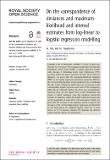Files in this item
On the correspondence of deviances and maximum-likelihood and interval estimates from log-linear to logistic regression modelling
Item metadata
| dc.contributor.author | Jing, Wei | |
| dc.contributor.author | Papathomas, Michail | |
| dc.date.accessioned | 2020-01-15T11:30:02Z | |
| dc.date.available | 2020-01-15T11:30:02Z | |
| dc.date.issued | 2020-01-15 | |
| dc.identifier | 263998577 | |
| dc.identifier | 68e0aae9-a42f-4dba-ad5e-2ab296219494 | |
| dc.identifier | 85079658003 | |
| dc.identifier | 000507382300023 | |
| dc.identifier.citation | Jing , W & Papathomas , M 2020 , ' On the correspondence of deviances and maximum-likelihood and interval estimates from log-linear to logistic regression modelling ' , Royal Society Open Science , vol. 7 , no. 1 , 191483 . https://doi.org/10.1098/rsos.191483 | en |
| dc.identifier.issn | 2054-5703 | |
| dc.identifier.other | ORCID: /0000-0002-5897-695X/work/67525883 | |
| dc.identifier.uri | https://hdl.handle.net/10023/19286 | |
| dc.description | Funding: The first author would like to acknowledge the support of the School of Mathematics and Statistics, as well as CREEM, at the University of St Andrews, and the University of St Andrews St Leonard’s 7th Century Scholarship. | en |
| dc.description.abstract | Consider a set of categorical variables P where at least one, denoted by Y, is binary. The log-linear model that describes the contingency table counts implies a logistic regression model, with outcome Y. Extending results from Christensen (1997, Log-linear models and logistic regression, 2nd edn. New York, NY, Springer), we prove that the maximum-likelihood estimates (MLE) of the logistic regression parameters equals the MLE for the corresponding log-linear model parameters, also considering the case where contingency table factors are not present in the corresponding logistic regression and some of the contingency table cells are collapsed together. We prove that, asymptotically, standard errors are also equal. These results demonstrate the extent to which inferences from the log-linear framework translate to inferences within the logistic regression framework, on the magnitude of main effects and interactions. Finally, we prove that the deviance of the log-linear model is equal to the deviance of the corresponding logistic regression, provided that no cell observations are collapsed together when one or more factors in P∖{Y} become obsolete. We illustrate the derived results with the analysis of a real dataset. | |
| dc.format.extent | 13 | |
| dc.format.extent | 359109 | |
| dc.language.iso | eng | |
| dc.relation.ispartof | Royal Society Open Science | en |
| dc.subject | Contingency table | en |
| dc.subject | Generalized linear modelling | en |
| dc.subject | Categorical variables | en |
| dc.subject | QA Mathematics | en |
| dc.subject | T-NDAS | en |
| dc.subject.lcc | QA | en |
| dc.title | On the correspondence of deviances and maximum-likelihood and interval estimates from log-linear to logistic regression modelling | en |
| dc.type | Journal article | en |
| dc.contributor.institution | University of St Andrews. School of Mathematics and Statistics | en |
| dc.contributor.institution | University of St Andrews. Centre for Research into Ecological & Environmental Modelling | en |
| dc.identifier.doi | 10.1098/rsos.191483 | |
| dc.description.status | Peer reviewed | en |
| dc.identifier.url | http://dx.doi.org/10.1098/rsos.191483 | en |
This item appears in the following Collection(s)
Items in the St Andrews Research Repository are protected by copyright, with all rights reserved, unless otherwise indicated.

